Kothari D.P., Nagrath I.J. Modern Power Systems Analysis
Подождите немного. Документ загружается.

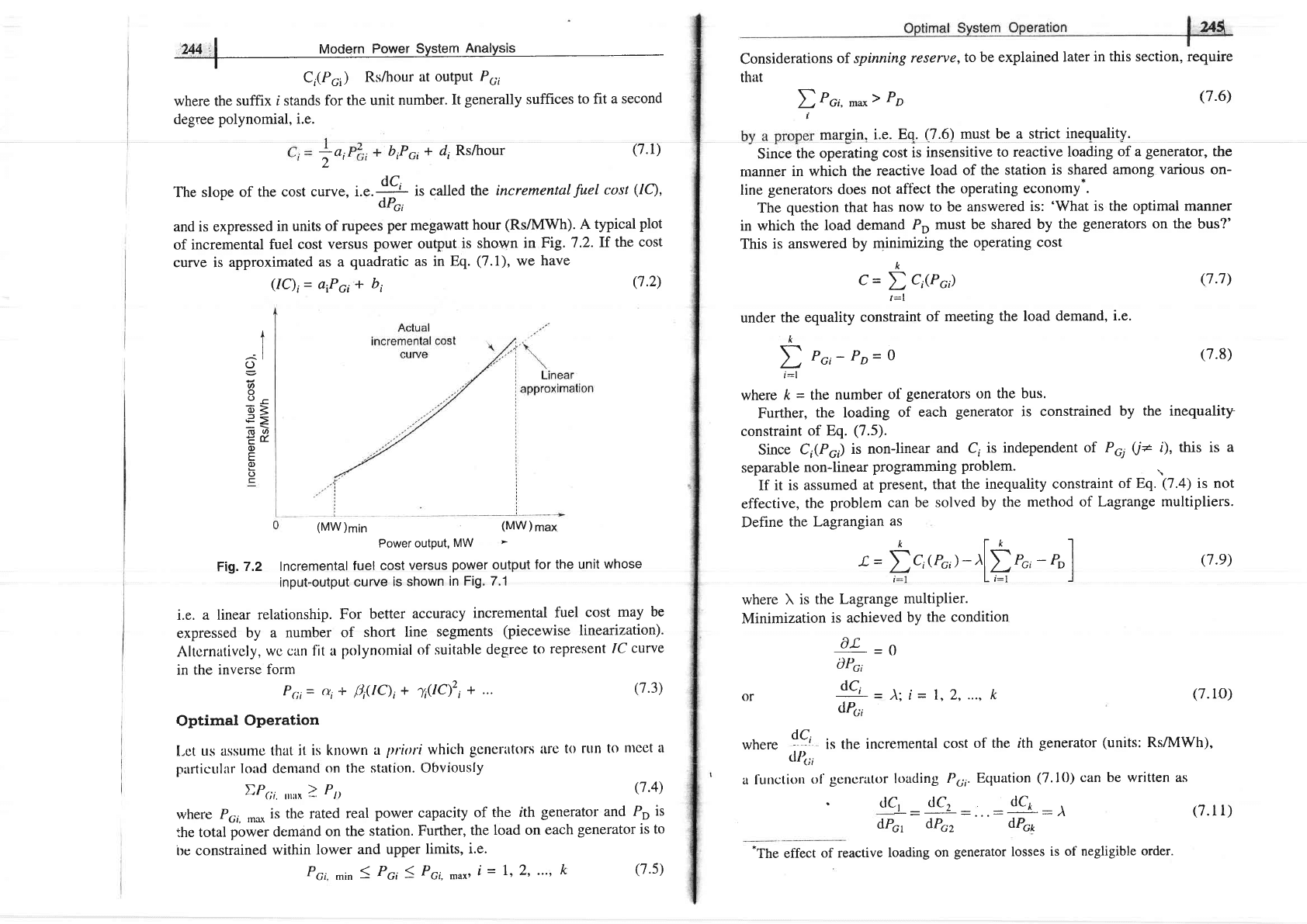
_Q;
2
The slope
of the
cost curve,
i.".43
is
called
the
incremental
Juel
cost
(lQ,
dPo,
and is expressed
in
units of
rupees
per
megawatt
hour
(Rs/lvIWh).
A
typical
plot
of incremental
fuel
cost
versus
power
output
is sho.wn
in Fig.
7.2.If
the
cost
curve is
approximated
as a
quadratic as in
Eq.
(7.1),
we
have
| .. - - A---!-- A-^r--^:-
.L4+
|
MOOern
rower DySIeIrl
Arlaly
I
Ci(Pc)
Rs/hour
at outPut
Pc,
where the
suffix i stands
for the
unit number.
It
generatly
suffices
to fit
a second
degree
polynomial, i.e.
Considerations
of spinning
reserve,
to be explained
later
in this section, require
that
D
Po,,
^*)
Po
marsin.
i.e.
Eq.
(7.6)
must
be a strict
inequality.
Since
the operating
cost
is insensitive
to reactive
loading
of a
generator,
the
rnanner
in which
the
reactive
load
of the station
is shared
among
various
on-
line
generators does
not
afl'ect
the operating
economy'.
The
question
that
has
now to be
answered
is:
'What
is the optimal manner
in
which the
load demand
Po must
be shared
by the
generators on the
bus?'
This
is
answered
by
minimizing
the operating
cost
k
c
=
D
ci(pci)
f:l
under
the equality
constraint
of
meeting
the load
demand,
i.e.
(
f-\Dl
L
'Gi-Po=O
i:t
where
k
=
the
number
of
generators on the bus.
Further,
the loading
of
each
generator
is constrained
by the inequality
constraint
of
Eq.
(7.5).
Since
Ci(Pc)
is non-linear
and
C,
is independent
of P6t
(i+
i), this is
a
separable
non-linear
programming
problem.
\
If
it is assumed
at
present, that the
inequality constraint
of Eq.
Q.q
is not
effective,
the
problem can
be solved
by the
method of
Lagrange multipliers.
Define
the
Lagrangian
as
b,Pc,
+ d,
Rs/hour
(7.r)
(7.2)
(7.3)
(7.4)
of the ith
generator
Equation
(7.10)
can
dC^
\
dPoo
(7.6)
(7.7)
(7.8)
(7.e)
(7.1o)
(units:
Rs/TvIWh),
be written as
(lc)i=
aiP"t
+
bt
(MW
)min
(MW
)
max
Power output,
MW
Fig.7.2
Incremental
fuel cost
versus
power
output
for
the unit
whose
input-output
curve
is
shown
in
Fig. 7.1
i.e. a
linear
relationship.
For
better
accuracy
incremental
fuel
cost
may
be
expressed
by a number
of
short
line
segments
(piecewise lineanzation).
Altcrnativcly,
wc
can fit a
polynomial
of suitable
degree
to
represent
IC
curve
in the
inverse
form
Pc;i=
a, +
{),(lC)i
+
1,QC)',
+ ...
Optimal
Operation
[,et
us assulne
that it
is known
a
priltri
which
generutors
itre
t<l rtln
to
ntcct
a
p:.rrticular
load
clenrand
on
the statton.
Ubvtously
f-
where
X
is the
Lagrange
multiplier.
Minimization
is achieved
by the
condition
of,
=o
dPo,
dC
or
'i
-
)i i
=
1,2,
..., k
dPc,
where
lci
is the
incremental
cost
d4,,
a Iurctio'
ol'.gencra,il;,":':t
:":
d4(il-
dr--
l
I
I
-i.
I
(J
o
o
oc
EB
,d>
oo
Etr
o
E
E
()
it
(Pci)-^[f
"",
-""]
DPr,,,
,'',,*
)
P,
where Pci,
,r.,,"*
is
the rated
real
power
capacity
of the
ith
generator
and
Po
is
the total
power demand
on
the station.
Further,
the
load on
each
generator is to
irc constrained
within
lower
and upper
limits,
i.e.
Pcr,
.in
1
Po,
1
Po,,
rn.*,
I
=
L, 2,
"',
k
(7.s)
*The
effect
of reactive
loading
on
generator losses
is of negligible
order.
(7.
r
l)
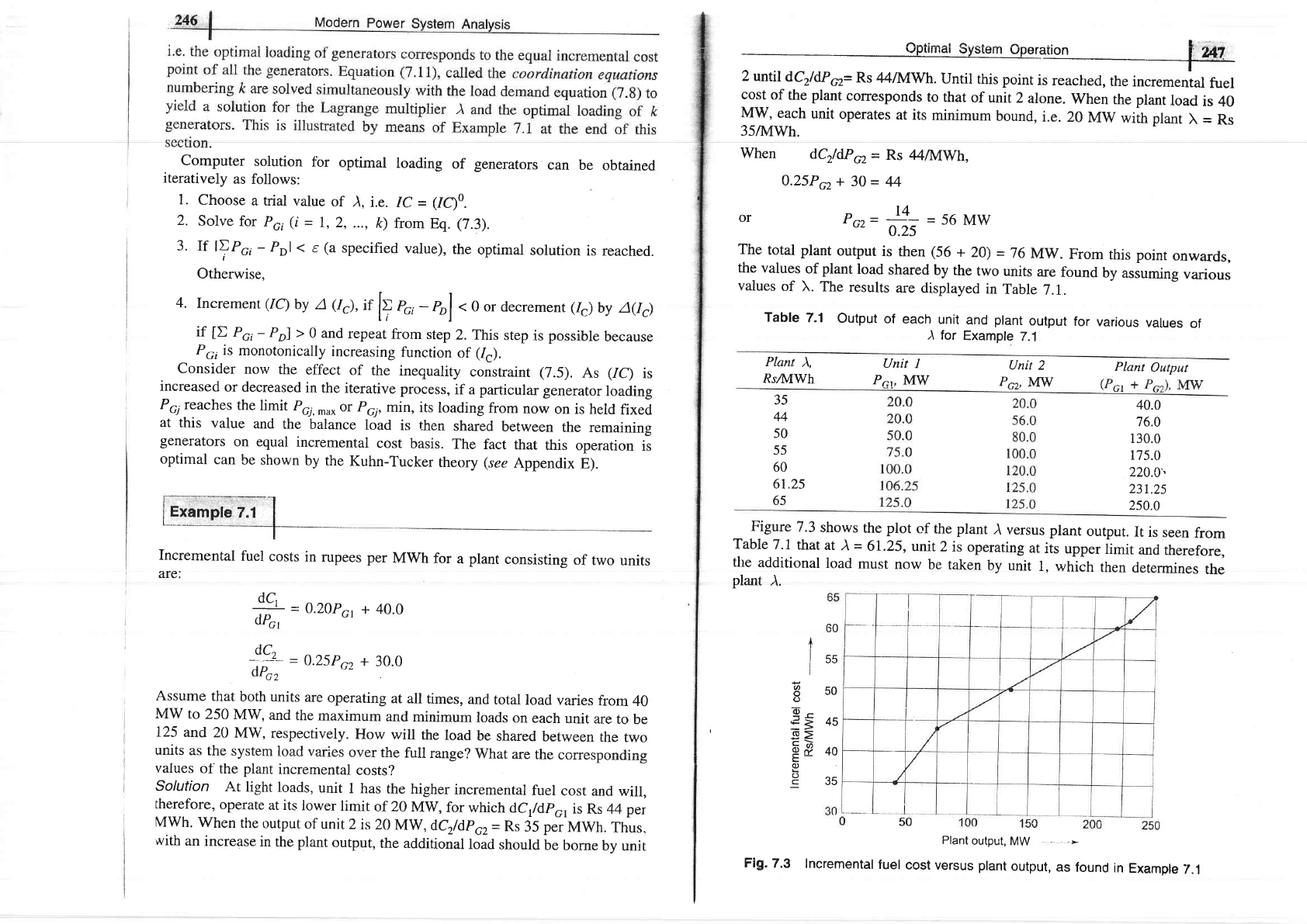
Computer
solution
fbr
optimal
loa<ling
of
generators
can
be
obtained
iteratively
as
follows:
1.
Choose
a trial
value
of
),
i.e.
IC
=
(IC)o.
2.
Solve
for
P",
(i
=
1,
2,
...,
k)
from
Eq.
(7.3).
3. If
ItPc,-
Pol
<
e(a
specified
value),
the
optimal
solution
is
reached.
Otherwise,
4.
Increment (lC)
bv
A
(1"),
t
I:
I
fl
Po,-
,rl
<
0 or
decrement (/c)
by A(tr)
if
[D
Pc,
-
Pr] r
0 and
repeat
from
step
2. This
step
is
possible
because
P.-,
is
monotonically
increasing
function
of
(1g).
consider
now
the
effecr
of
the
inequality
constraint (7.5).
As
(1c)
is
increased
or decreased
in
the
iterative
process,
if a
particular
generator
loading
P",
reaches
the
limit
PGi,^o
or P6;,
min,
its
loading
from
now
on is held
fixed
at
this
value
and
the
balance
load
is
then
shared
between
the remaining
generators
on equal
incremental
cost
basis.
The
fact
that
this
operation
is
optimal
can
be
shown
by
rhe
Kuhn-Tucker
theory
(see
Appendix
n;.
Incremental
fuel
costs
in
rupees per
MWh
for
a
plant
consisting
of
two
units
are:
dt
i*-o.2opct+40.0
G1
-dcz-
=
o.2,pcz+
3o.o
dPo,
Assume
that
both units
are
operating
at
all
times,
and
total
load
varies
from
40
MW
to
250
MW,
and
the
maximum
and
minimum
loads
on
each
unit are
to
be
I25
and
20
MW,
respectively.
How
will
the
load
be
shared
between
the
two
units
as
the
system
load vanes
over
the
full
range?
What
are
the
corresponding
values
of
the
plant
incremental
costs?
Solution
At light
loads,
unit
t
has the
higher
incremental
fuel
cost
and
will,
therefore,
operare
at its
lower
limit
of
zo
Mw,
for
which
dcrldpcr
is
Rs 44 per
MWh.
When
the
ourput
of unit
2is20
MW,
dczldpcz=
Rs
35
p"i
UWt.
Thus,
with
an
increase
in
the
plant
output,
the additional
load
should
be borne
bv unit
n-.:-^r A-^^r--- ^ .. L -^-
cost
of
the plant
colresponds
to
that
of unit
2
alone.
When
rhe plant
load
is
40
Mw,
each
unit
operates
at its
minimum
bound,
i.e.2o
Mw
wiitr
plant
\
=
Rs
35/I4Wh.
When
dczldPcz=
Rs 44/MWh,
0.25PG2+
30
-
44
or
pnt
=
JI-
=
56
MW
0.25
The
total plant
output
is then
(56
+
20)
=
76
MW.
From
this point
onwards,
the values
of
plant
load
shared
by
the
two
units
are
found
by
assuming
various
values
of
\.
The
results
are displayed
in
Table
7.1.
Table
7-1
Output
of
each
unit
and
plant
output
for
various
values
of
) for
Example
7.1
Plant
),
RszMWh
35
44
50
55
60
61.25
65
40.0
76.0
130.0
175.0
220.0\
231.25
250.0
Figure
7.3
shows
the plot
of
the plant
.tr
versus
plant
output.
It
is
seen
from
Table
7.7
that
at .\
=
61.25,
unit
2
is
operating
at
its
upper
limit
and
therefore,
the
additional
load
must
now
be
taken
by
unit
1,
which
then
determines
the
plant
).
60
+
t--
lcc
I
850
o
@^
i=
45
a>
EP 40
t-
E
O
cJc
Plant
output,
MW
Fig.7.3
Incremental
fuel
cost versus
plant
output,
as found
in
Example
7.1
Unit
I
Unit
2
Pcz,
NfW
Plant
Output
Pcl,
MW
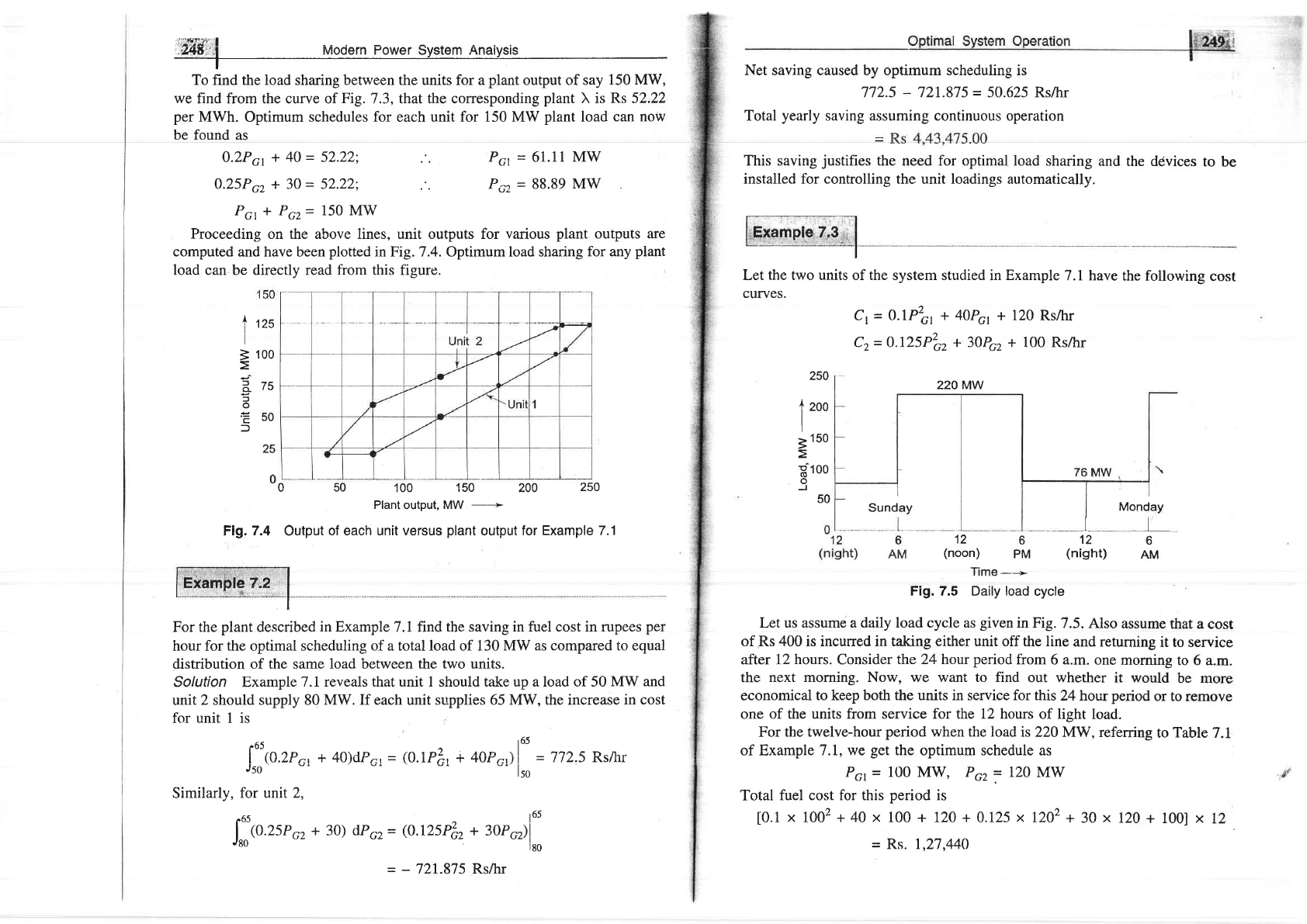
t:Hzut"l
.Z.48:
i
Mocjern Power System nnaiysis
To find the load sharing between the units for a
plant
output of say
150 MW,
we
find from the curve of
Fig.
7.3, that the corresponding
plant
X is
Rs
52,22
per
MWh. Optimum schedules for each unit for 150 MW
plant
load
can now
be found
as
Net saving caused by optimum scheduling is
772.5
-
721.875
=
50.625 Rs/lr
Total
yearly
saving
assuming
continuous operation
This saving
justifies
the need for optimal
installed for controlling
the unit loadings
load
sharing
and the ddvices
to be
automaticallv.
0.2Pa*40-52.22;
0.25PG2 +
30=
52.22;
Pcr
+ Pcz= 150 MW
Proceeding on the above lines, unit outputs for
various
plant
outputs are
computed and have been
plotted
in Fig. 7.4. Optimum load sharing
for any
plant
load can be directlv read from this fieure.
Pct
=
61'11
MW
Pcz
=
88'89
MW
100
150
200
250
Plant
output,
MW
-_-->
unit versus
plant
output for
Example 7.1
For the
plant
described
in ExampleT.l
find
the saving in fuel cost in rupees
per
hour for the optimal scheduling of a total load of 130 MW
as compared to equal
distribution of the same
load between the two units.
Solution Example 7.I
reveals that
unit
I should take up a load of 50
MW and
unit 2 should supply 80
MW. If each
unit
supplies
65
MW, the increase in
cost
for unit 1 is
165rnnn . ,^\rn rr.'tnZ
|
\U.LI'r:r
t *U)|JIl
nr
=
(U.Ifnt
Jso
'
Similarly, for
unit 2,
J*co.rs"
",
+
30)
dpor=
(0.
r25PGz+
:oro;1"
Let the two units of the svstem studied
curves.
in Example
7.1 have
the following
cost
Cr
=
0.lPto, + 40Pc + 120
Rs/hr
Cz= 0.l25Pzcz
+
30Po, + 100 Rsftrr
220 MW
Monday
12
ll
126
(noon)
PM
(night)
AM
Time
-----
Fig. 7.5 Daily load
cycle
Let us assume a daily load cycle as
given
in Fig.
7.5. Also
assume
that a
cost
of Rs 400 is incurred in taking
either
unit off the line
and returning
it to service
after 12
hours.
Consider
the 24 hour
period
from
6 a.m. one
morning
to 6 a.m.
the
next morning. Now, we want to find
out whether
it would
be more
economical
to keep both the units in service for this
24hour
period
or to remove
one
of the units from service for the 12 hours
of light load.
For the twelve-hour
period
when the
load
is 220
MW, referring
to
Table
7.1
of Example 7.1, we
get
the
optimum schedule as
Pcr= 100 MW'
Pcz
=
120 MW
Total fuel
cost for
this
period
is
[0.1
x
1002+40x 100+ 120+0.125x1202
+30 x720
+ 100]
x12
=
Rs. 1,27,440
I
tzs
I
=
100
Eru
o
E50
f
250
t
200
I
I
3
150
E
100
o
J
50
050
Flg.7.4 Output
of each
165
; lf\r1 rl
Fn^
a D^tL-
t'tUI'6yll
=
llL.J
l\S/I[
"'
lso
Sunday
-
-
721.875 Rs/hr
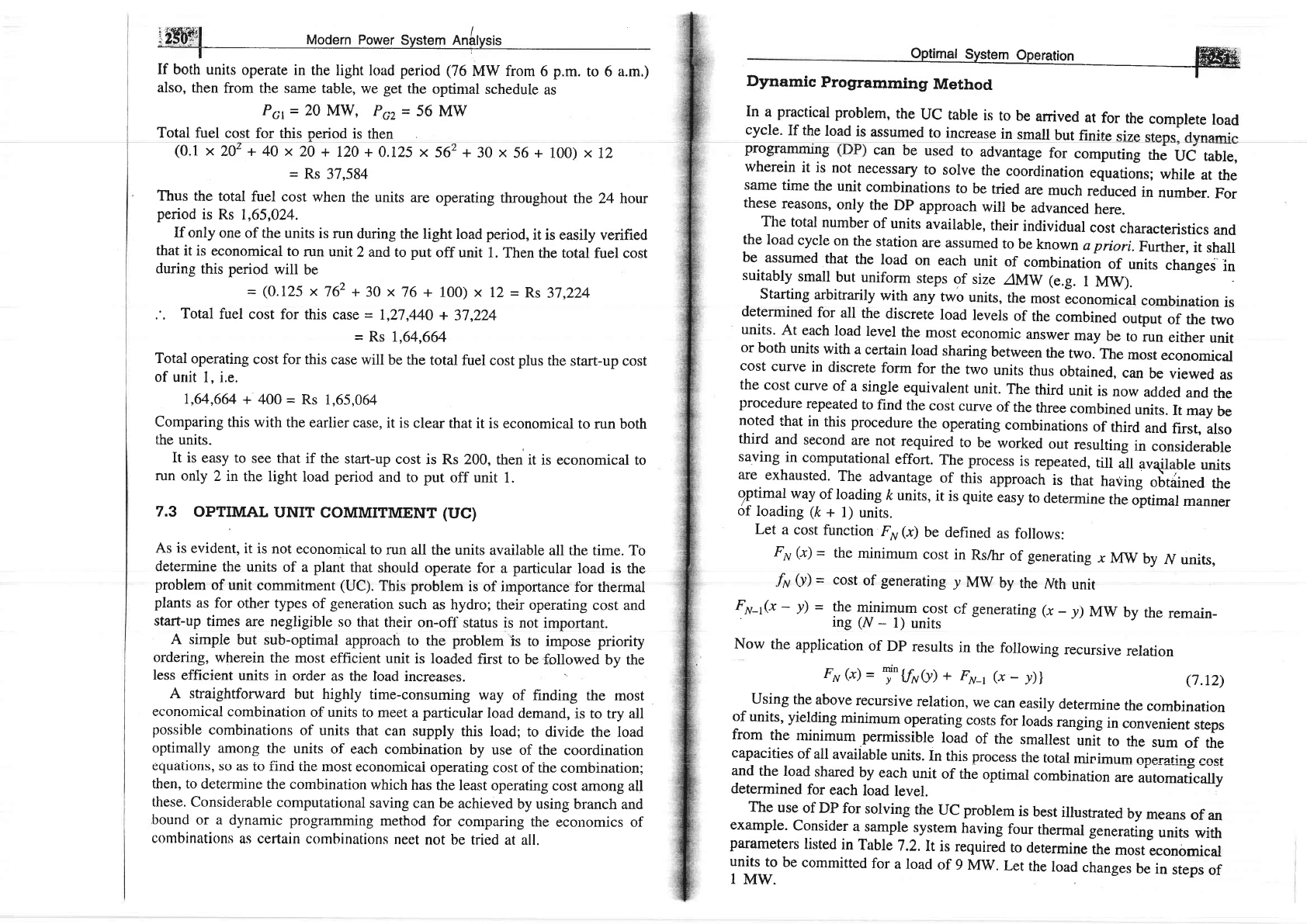
ltgtiFl
Modern
power
svstem
nnAVsis
--t
If
both
units
operate in
the light
load
period (76
MW from
6
p.m.
to 6
a.m.)
also,
then
from the
same table,
we
get
the
optimal
schedule
as
Pcr
=
20
MW, Pcz
=
56
MW
Total fuel
cost
for this
period
is then
(0.1
x
20' + 40 x
20
+ 120 +
0.125x56
+30x56+100)x12
=
Rs
37,584
Thus the
total
fuel cost
when
the units
are
operating
throughout
the 24 hour
period
is Rs
I,65,024.
If only
one
of the units
is run
during
the light
load
period,
it is easily
verified
that
it is economical
to
run unit
2 and
to
put
off unit 1.
Then
the total
fuel cost
during
this periot:tXf
':
762 +
3o
x
76+
100)
x
rz
=
Rs
37,224
Total
fuel
cost for
this
case
=
L,27,440
+
37,224
=
Rs 1,64,664
Total
operating
cost for this
case
will be the
total
fuel cost
plus
the start-up cost
of unit
l, i.e.
1,64,6&
+
400
=
Rs 1,65,064
Comparing
this
with the earlier
case,
it is clear
that
it is economical
to run both
the
units.
It is
easy to
see that
if the
start-up
cost
is Rs 200,
then
it is economical
to
run
only
2 in
the light
load
period
and
to
put
off unit
1.
7.3
OPTTMAL
UNrT
COMMTTMENT (UC)
As
is
evident,
it
is not economical
to
run all
the units
available
all the time.
To
determine
the
units of
a
plant
that
should
operate for
a
particular
load is
the
problem
of unit
commitment
(UC).
This
problem
is of importance
fbr thermal
plants
as for
other types
of
generation
such
as hydro;
their
operating
cost and
start-up
times
are negligible
so
that
their on-off
status
is not
important.
A simple
but
sub-optimal
approach
to
the
problem
is to impose priority
ordering,
wherein
the
most efficient
unit is loaded
first to be'followed
by the
less
efficient
units
in order
as the Ioad
increases.
A straightforward
but
highly
time-consuming
way of
finding the
most
economical
combination
of units
to meet
a
particular
load
demand,
is
to try all
possible
combinations
of units
that can
supply
this load;
to
divide
the
load
optimally
among
the
units
of each
combination
by use
of the
coordination
equaiions,
so
as to finci
the
most economicai
operating
cost
of the
combination;
then, to
determine
the combination
which
has
the least
operating
cost
among all
these.
Considerable
computational
saving
can
be achieved
by using
branch and
bound
or a
dynamic
programming
method
for
comparing
the
economics of
combinations
as certain combinations
neet
not be tried
at all.
t
-
Dynamic
Programming
Method
In
a
practical
problem,
the
UC
table
is
to be
arrived
at
for
the
complete
load
cycle.
If the
load
is
assumed
to
increase
in
small
but
finite
size stensl dvnamin
prograrrurung
can
be
used
to
advantage
for
computing
the
uc
table,
wherein
it is
not
necessary
to
solve
the
coordination
equations;
while
at
the
same
time
the
unit
combinations
to
be
tried
are
much
reduced
in
number.
For
these
reasons,
only
the
Dp
approach
will
be
advanced
here.
The
total
number
of
units
available,
their
individual
cost
characteristics
and
the
load
cycle
on
the
station
are
assumed
to
be
known
a priori.Further,
it
shall
be
assumed
that
the
load
on
each
unit
of
combination
of
units
changei'in
suitably
small
but
uniform
steps
of
size
/MW (e.g.
I
MW).
Starting
arbitrarily
with
any
two
units,
the
most
iconomical
combination
is
determined
for all
the
discrete
load
levels
of
the
combined
output
of the
two
units.
At
each
load
level
the
most
economic
answer
may
be
to
run
either
unit
or
both
units
with
a
certain
load
sharing
between
the
two.
The
most
economical
cost
curve
in discrete
form
for
the
two
units
thus
obtained,
can
be viewed
as
the
cost
curve
of
a single
equivalent
unit.
The
third
unit
is
now
added
and
the
procedure
repeated
to
find
the
cost
curve
of
the
three
combined
units.
It
may
be
noted
that
in
this procedure
the
operating
combinations
of
third
and
first,
also
third
and
second
are
not
required
to
be
worked
out
resulting
in
considerable
saving
in
computational
effort.
The process
is
repeated,
till
all
available
units
are
exhausted.
The
advantage
of
this
approach
is
that
having
oitiined
the
gPli-u.|
way,of
loading
ft units,
it is
quite
easy
ro
determine
the
Jptimal
manner
of
loading (ft
+
1)
units.
Let
a cost
function
F"
(x)
be defined
as
follows:
F,y
(x)
=
the
minimum
cost
in
Rs/hr
of
generating
.r
MW
by
N units,
fN
0)
=
cost
of
generating
y
MW
by
the
Nth
unit
F*-{x
-
y)
-
the
minimum
cosr
of
generating
(.r
-
y)
Mw
by
the
remain_
ing
(1/
-
t)
units
Now
the
application
of
DP
results
in
the
following
recursive
relation
FN
@)
=
Tn
Vn9)
*
Fu-r
@
-
y)|
(7.r2)
Using
the
above
recursive
relation,
we
can
easily
determine
the
combination
of
units,
yielding
minimum
operating
costs
for
loads
ranging
in
convenient
steps
from
the
minimum.permissible
load
of
the
smallest
unit
to
the
sum
of the
canaeifies nf
qll qrroiiol-lo
rr-i+o i- +L;^ --^^^-^ .1^- 1-1 r
.
$vs^rqurv
uurrD.
rrr LrrlD
PruuttJs
ure
total
nunlmum
oDerating eost
and
the
load
shared
by
each
unit
of
the
optimal
combination
are
;il.u,i"
determined
for
each
load
level.
The
use
of DP
for
solving
the
UC
problem
is
best
illustrated
by
means
of
an
example.
Consider
a
sample
system
having
four
thermal
generating
units
with
parameters
listed
in
Table
7.2.It
is required
to
determinr
th.
most-economical
units
to
be
committed
for
a load
of
9
MW.
Let
the
load
changes
be
in
steps
of
I
MW.
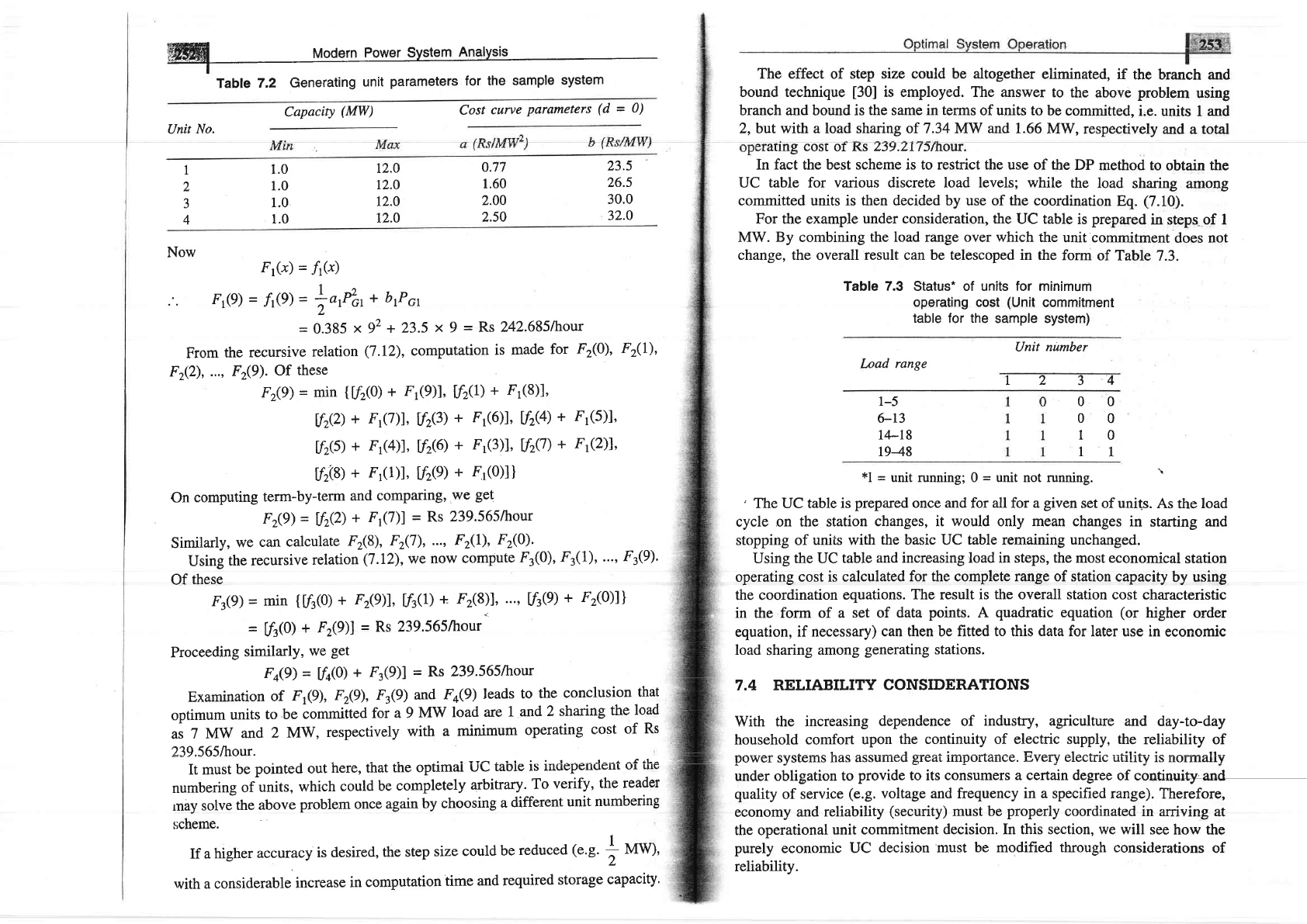
.
Modern
Pow
Table
7.2
Generating
unit
parameters
for
the
sample
system
Capacity
(MW) Cost
curve
pararneters
(d
=
0)
Unit No.
The effect
of
step size could be altogether
eliminated,
if
the branch and
bound technique
[30]
is employed. The answer
to
the above
problem
using
branch and bound is
the
same
in terms
of units to be
committed,
i,e.
units 1
and
2, but with a load sharing of 7 .34 MW and 1.66
MW,
respectively
and a total
graung
cost oI I<s
z,y.zL
/J/nour.
In fact the best scheme is to restrict the use of the
DP
method to
obtain
the
UC
table for various discrete load levels; while
the
load
sharing among
committed units is
then decided by use of
the
coordination
Eq.
(7.10).
For the example
under consideration,
the UC table
is
prepared
in
steps-
of I
MW.
By
combining
the load
range
over which
the
unit commitment
does
not
change, the
overall
result can be telescoped in the
form
of Table
7.3.
Table
7.3
Status* of units
for
minimum
operating cost
(Unit
commitment
table for the
sample system)
Load range
Unit number
r234
l-5
6-r3
t4-18
1948
*l
=
unit running;
0
=
unit not running.
\
'
The UC table is
prepared
once
and
for
all
for a
given
set of units.
As
the
load
cycle on
the station
changes, it
would
only mean changes
in starting and
stopping of
units with
the basic
UC
table remaining unchanged.
Using the UC
table
and increasing load in steps, the most economical
station
operating cost
is calculated
for the complete range of station
capacity
by using
the coordination
equations.
The result
is the
overall station cost characteristic
in the
form of a
set of data
points.
A
quadratic
equation
(or
higher order
equation,
if necessary)
can then be fitted
to
this
data
for later use in
economic
load
sharing
among
generating
stations.
7.4
RELIABILITY
CONSIDERATIONS
With
the increasing
dependence of
industry, agriculture
and
day-to-day
household comfort
upon
the continuity of electric supply, the
reliability of
power
systems
has
assumed
great
importance. Every eleciric utilify
is normaily
under obligation
to
provide
to its
consumers a certain degree
of continuigl
and
quality
of service
(e.g.
voltage and frequency in
a
specified range).
Therefore,
economy
and reliability
(security)
must
be
properly
coordinated in
arriving at
the operational
unit commitment
decision. In this section, we will
see how the
purely
economic
UC
decision must
be modified through considerations
of
reliability.
1
2
3
4
Now
Ft@)
=
ft@)
fr(9)
=
f{9)=
LorP'ot+
btPcr
=
ollss
x
92
+
23.5
x9
=
Rs
242.685lhour
From
the recursive
relation
(7.12),
computation
is
made
for
F2(0),
Fz(l),
Fz(2),
...,
Fz(9).Of
these
FzQ)
=
min
tt6(0)
+
Ft(9)1,
VzG)
+ Ft(8)l'
VzQ)
+ Ft(7)1,
VzQ)
+ Fr(6)l'
Vz@)
+
F1(5)l'
t6(5)
+ Fr(4)1,
VzG)
+ Ft(3)1,
VzT
+ Fr(2)1,
tfr(s)
+ F,(1)1,
vzg)
+
Fr(O)l)
On
computing
term-by-term
and
compdng,
we
get
FzQ)
=
Vz(2)
+
Ft(1))
=
Rs 239.5651how
Similarly,
we
can
calculate
Fz(8),
Fz(1),
...,
Fz(l),
Fz(O).
Using
the recursive
relation
(7.12),
we
now
compute
Fl(O),
F:(1),
...'
F3(9).
Of
these
Fse)=
min
{t6(0)
+ Fr(9)f,
t6(1)
+ Fl8)1,
...'[6(9)
+
rr(0)]]
=
[6(0)
+ FzQ)l
=
Rs
239.565ftour
Proceeding
similarly,
we
get
FoQ)
=
[f4(0)
+ Fr(9)]
=
Rs
239.565lhour
Examination
of
Fr(9),
Fz(9),
Fl(9)
and
Fa(9)
leads
to
the
conclusion
that
optimum
units
to be
lommitted
for a 9
MW
load
are
1
and
2 sharing
the
load
ur
Z
l,tW
and
2
MW,
respectively
with
a minimum
operating
cost
of Rs
239.565/hour.
It must
be
pointed out
here, that
the
optimai
iiC
tabie
is
inclependent
of
'u\e
numbering
of
units,
which
could
be
completely
arbitrary.
To
verify,
the
reader
rnay
solvethe
above
problem once
again
by
choosing
a
different
unit numbering
scheme.
If a
higher
accuracy
is desired,
the step
size
could
be
reduced
(e.g.
*
t*r,
with
a considerable
increase
in
computation
time
and
required
storage
capacity.
1.0
1.0
1.0
1.0
12.0
12.0
12.0
12.0
0.77
1.60
2.00
2.50
23.5
26.5
30.0
32.0
00
00
10
11
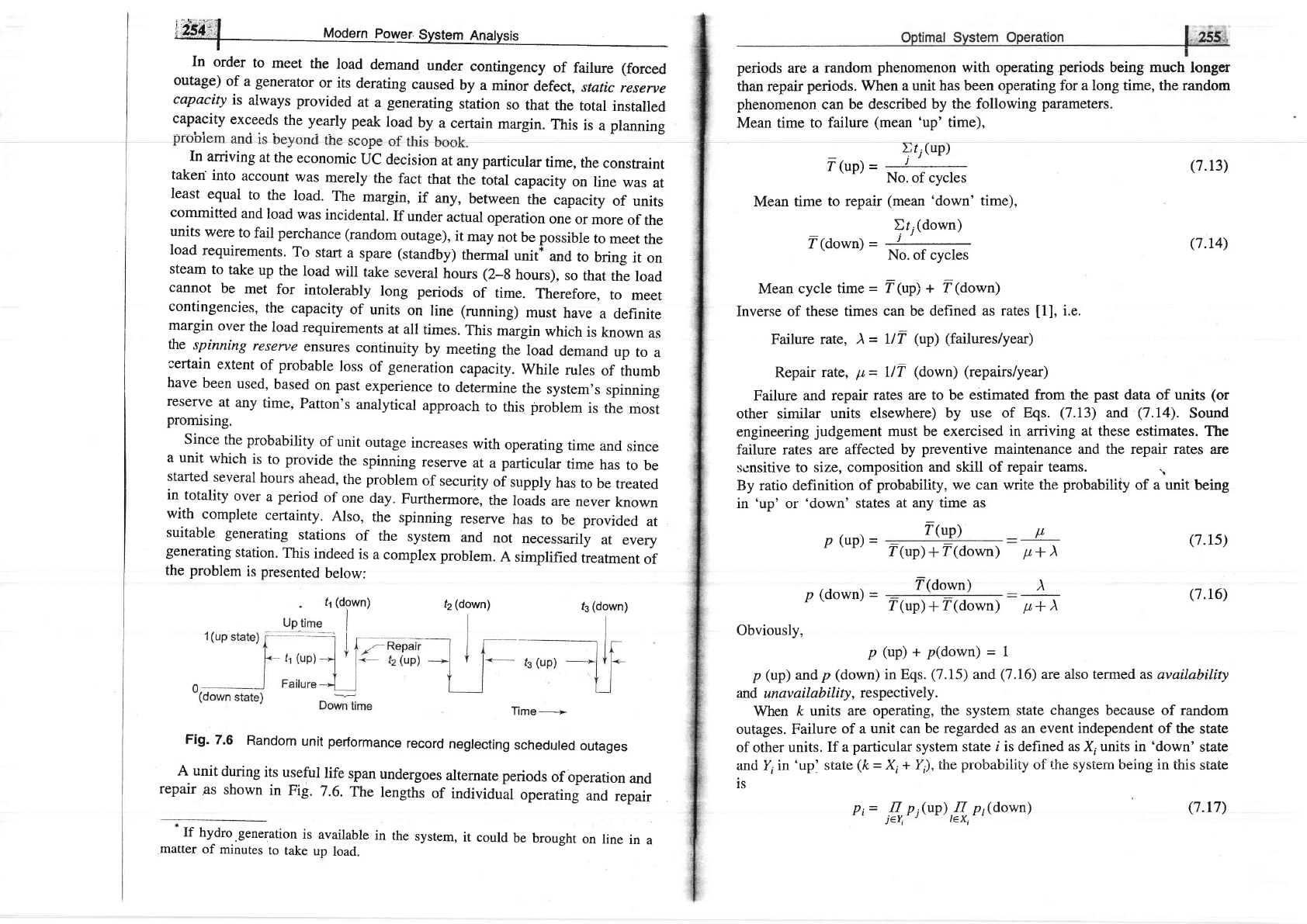
In
order
to
meet
the
load
demand
under
contingency
of
failure (forced
outage)
of
a
generator
or
its
derating
caused
by
a
minor
defect,
static
reserve
capacity
is
always
provided
at a
generating
station
so
that
the
total
installed
capacity
exceeds
the yearly
peak
load
by
a
certain
margin.
This
is
a
planning
In
arriving
at
the
economic
UC
decision
at
any
particular
time,
the
constraint
taken
into
account
was
merely
the
fact
that
the
total
capacity
on
line
was
at
least
equal
to
the
load.
The
margin,
if
any,
between
the
capacity
of
units
committed
and
load
was
incidental.
If
under
actual
operation
one
or
more
of
the
units
were
to
fail perchance
(random
outage),
it
may
not
be
possible
to
meet
the
load
requirements.
To
start
a
spare
(standby)
thermal
unit*
and
to
bring
it
on
steam
to
take
up
the
load
will
take
several
hours
(2-8
hours),
so
that
the
load
cannot
be
met
for
intolerably
long
periods
of
time.
Therefore,
to
meet
contingencies,
the
capacity
of
units
on
line
(running)
must
have
a
definite
margin
over
the
load
requirements
at
all
times.
This
margin
which
is
known
as
the
spinning
reserve
ensures
continuity
by
meeting
the
load
demand
up
to
a
certain
extent
of
probable
loss
of
generation
capacity.
While
rules
of
thumb
have
been
used,
based
on
past
experience
to
determine
the
system's
spinning
reserve
at
any
time,
Patton's
analytical
approach
to
this
problem
is
the
most
promising.
Since
the probability
of unit
outage
increases
with
operating
time
and
since
a
unit
which
is
to provide
the
spinning
reserve
at
a
particular
time
has
to
be
started
several
hours
ahead,
the problem
of
security
of
supply
has
to
be
treated
in
totality
over
a
period
of
one
day.
Furthefinore,
the
loads
are
never
known
with
complete
certainty.
Also,
the
spinning
reserve
has
to
be
provided
at
suitable
generating
stations
of
the
system
and
not
necessarily
at
every
generating
station.
This
indeed
is a
complex
problem.
A
simplified
treatment
of
the
problem
is presented
below:
f1(down)
f2
(down)
f3
(down)
Time-------->
Fig.
7.6
Random
unit
performance
record
neglecting
scheduled
outages
A unit
during
its
useful
life
span
undergoes
alternate
periods
of operation
and
repair
as
shown
in
Fig.
7.6.
The
lengths
of
individual
operating
and
repair
periods
are a
random
phenomenon with
operating
periods
being
much
longer
than repair
periods.
When
a unit has been
operating for a long time, the random
phenomenon
can
be described
by the following
parameters.
Mean time to
failure
(mean
'up'
time),
Mean time
to repair
(mean
'down'
time),
Et,
(down)
Z
(down)
No. of cycles
No. of cycles
z(up)
*
z(down)
Z(down)
(7.13)
(7.r4)
(7.rs)
(7.16)
Mean cycle
time
=
f
(up)
+ Z(down)
Inverse of
these times
can be defined
as rates
[1],
i.e.
Failure
rate, A
=
IIT
(up) (failures/year)
Repair rate,
trt
=
llT
(down)
(repairs/year)
Failure
and repair
rates are to be
estimated from the
past
data of units
(or
other similar
units elsewhere)
by use of Eqs.
(7.13)
and
(7.I4).
Sound
engineering
judgement
must
be exercised in arriving
at these estimates.
The
failure
rates
are
affected by
preventive
maintenance and the repair rates
are
scnsitive to size,
composition
and skill of repair teams.
.r
By ratio definition
of
probability, we can write the
probabiliiy
of a unit
being
in
'up'
or
'down'
states
at any time as
r(up)
_
l.t
p
(up)
=
P
(down)
=
p+
A
)
Z(up)
*
Z(down)
tr+
A
Obviously,
p
(up)
+
p(down)
=
1
p
(up)
and
p
(down)
in Eqs.
(7.15)
and
(7.16)
are also termed
as availability
and unavailability,
respectively.
When
ft units are
operating,
the system state
changes
because of random
outages. Failure
of a
unit can be
regarded
as an
event independent
of the
state
of other
units.
If a
particular system state
i is defined as X, units in
'down'
state
1
r,
'
(
t ---t- lr \/ .
rz\
!l-- -----1--l-:1:--- ^t
L1^^
l-^:-^ 2- tLl
an0 I
j
ln
Up. Stale
\K
=
i
+ I
)t
urs
PIUDaUITILy
Ur
urtr systelll
Utrltr$ ttl ulIS Slaltr
is
pt
=
{r,r;(ul),{*
ot(down)
.
If
hy^dro.generation
is
available
in
the
system,
it
could
be
brought
on
line
in
a
matter
of
minutes
to
take
up
load.
(7.r7)
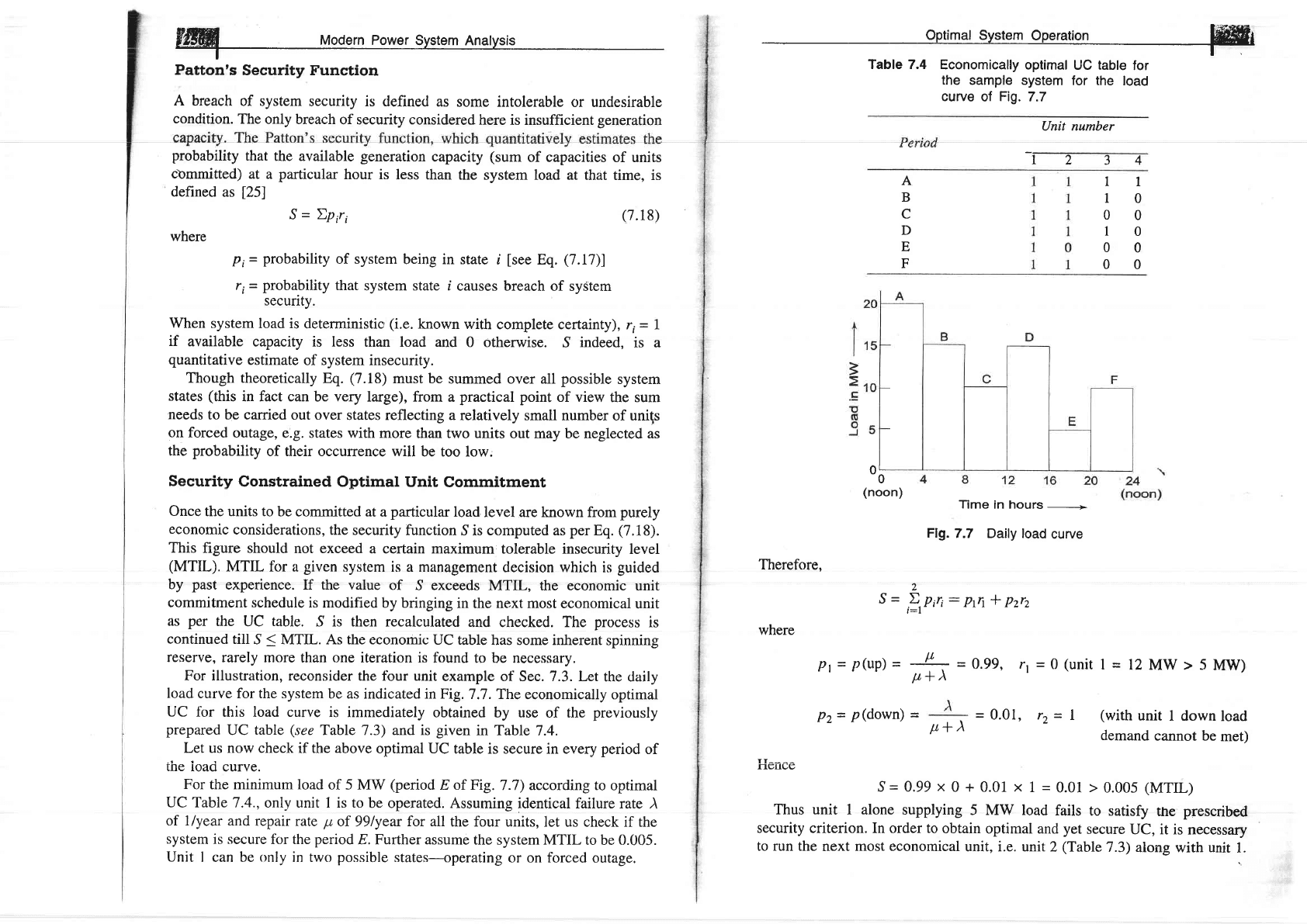
gW
Modern Power
system
Analysis
I
Patton's
Security Function
A
breach of system
security is defined
as
some intolerable
or undesirable
condition.
The
only breach
of security considered
here is insufficient
generation
probability
that
the available
generation
capacity
(sum
of capacities
cbmmitted)
at
a
particular
hour is
less than
the system load at
that
defined
as
[25]
S
=
Ep,r,
where
of units
time, is
(7.18)
p,
=
probability
of system
being in state
i
[see
Eq.
(7.17)]
r,
=
probability
that
system state i
causes breach
of syStem
securlty.
When
system load is
deterministic
(i.e.
known with
complete certainty),
r,
=
1
if
available
capacity is less
than load and
0 otherwise.
S
indeed,
is a
quantitative
estimate
of system insecurity.
Though theoretically
Eq.
(7.18)
must be
summed over all
possible
system
states
(this
in fact can
be
very
large), from
a
practical
point
of view
the sum
needs
to be caried
out over
states reflecting a
relatively small number
of uniqs
on forced
outage,
e.g. states with more
than two units
out may be neglected as
the
probability
of their occurrence will
be too
low;
Security
Constrained
Optimal Unit
Commitment
Once
the units to
be committed at
a
particular
load
level are known from
purely
economic
considerations,
the
security function
S is computed as
per
Eq.
(7.18).
This
figure should
not exceed
a certain maximum'tolerable
insecurity
level
(MTIL).
MTIL for a
givcn
system is a management
decision which
is
guided
by
past
experience. If the value
of
S exceeds MTIL,
the economic unit
commitment schedule
is
modified by bringing
in
the next most economical
unit
as
per
the
UC
table.
S
is then
recalculated
and checked. The
process
is
continued
till ^t
<
MTIL. As the economic
UC table
has some inherent
spinning
reserve,
rarely more
than
one
iteration is
found to
be
necessary.
For illustration,
reconsider the fbur unit
example of Sec. 7.3. Let
the daily
load
curve for the system
be as indicated in Fig.
7.7. The
economically optimal
UC fbr
this load curve
is immediately
obtained
by
use
of the
previously
prepared
UC
table
(see
Table 7.3) and is
given
in TabIe
7.4.
Let us now check
if the above
optimal UC
table is secure in every
period
of
the
ioaci curve.
For
the minimum load
of 5 MW
(period
E of Fig.
7.7) according to
optimal
UC Table
7.4., only unit 1 is to
be operated.
Assuming identical failure rate
)
of l/year and
repair rate
pr,
of
99/year
for all
the four
units, let us check if the
system
is secure
fcrr the
period
E. Further assume
the system MTIL
to be 0.005.
Unit
I can be
only
in two
possible
states-operating
or on forced
outage.
WWt
the
sample system
for the
load
curve
of
Fig.
7.7
Unit number
t234
A
B
C
D
E
F
1
0
0
0
0
0
I
I
0
I
0
0
Therefore,
where
Time
in hours
------------>
Flg.7.7
Daily load
curye
2
S
=
,?
piti
:
p1r1* p2r2
Pr
=
P(up)
=
ffi
=
0.99, rr
=
0
(unit
I
=
12
MW
> 5
MW)
pz=
p(down)
=
p+
^
=
0.01
,
rz
=
t
(with
unit
I down
load
demand
cannot be
met)
Hence
S= 0.99
x
0
+
0.01
x
1
=
0.01
>
0.005
(MTIL)
Thus unit
I alone supplying
5 MW load
fails to satisfy
tne
prescribed
security criterion. In order to
obtain
optimal and
yet
secure
UC, it
is necessary
to run the
next
most economical
unit, i.e. unit
2
(Table
7.3)
along
with
unit
1.
0L
0
(noon)
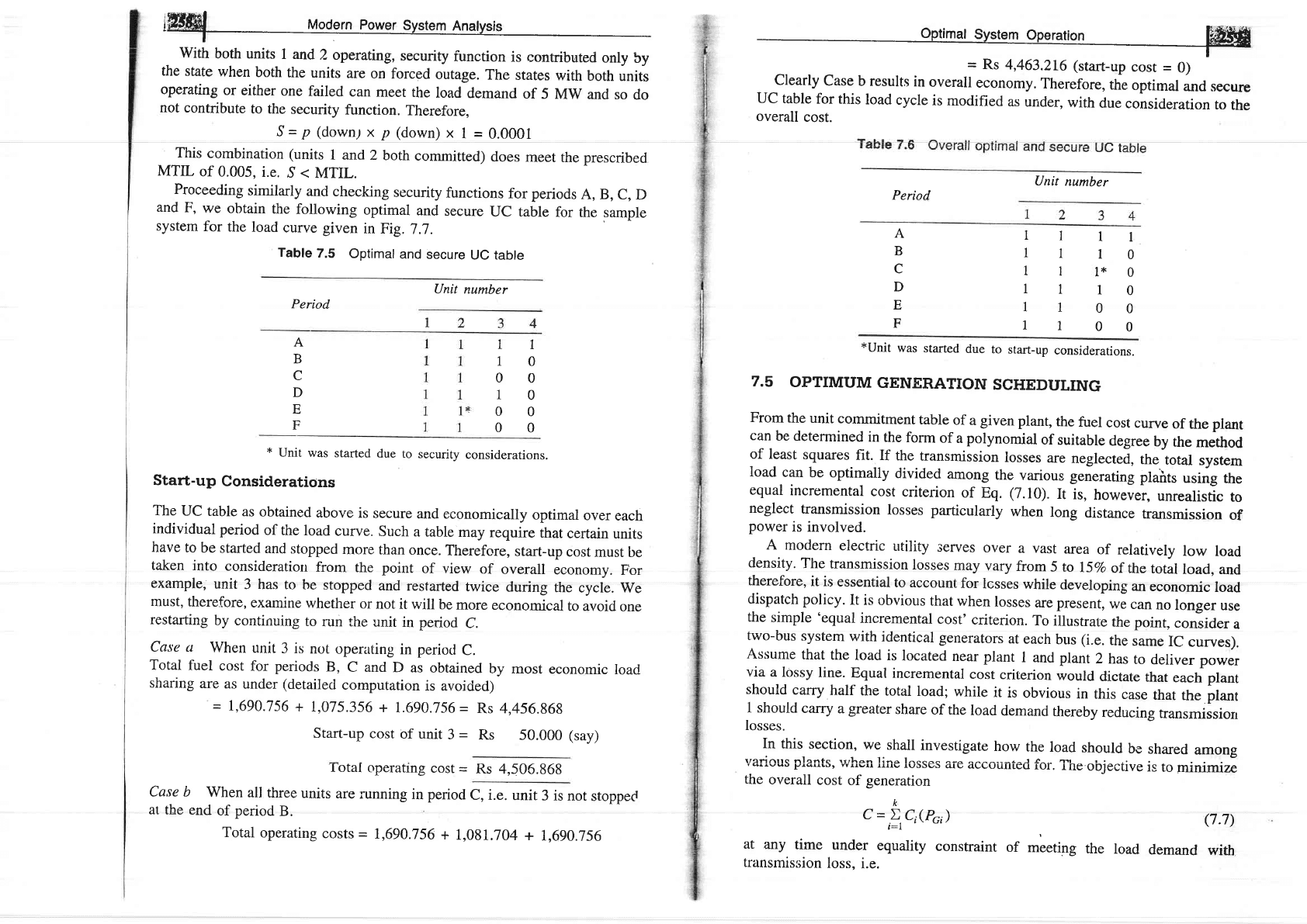
ifl5
"#Wl
Mooern
power
System
Rnarysis
With
both units
I and
2 operating,
security
function
is contributed
only
by
the state
when
both
the
units
are
on
forced
outage.
The
states
with
both
units
operating
or either
one
failed
can
meet
the
load
demand
of
5
MW and
so
do
not
contribute
to the
security
function.
Therefore,
S
=
p (down;
x p
(down)
x
1
=
0.0001
This
combination
(units
1 and
2both
committed)
does
meet
the prescribed
MTIL
of
0.005,
i.e.
^S <
MTIL.
Proceeding
similarly
and
checking
security
functions
for periods
A, B,
c,
D
and
F,
we
obtain
the
following
optimal
and
secure
UC table
for the
sample
system
for
the load
curve
given
in
Fig.
7.7.
Table
7.5
Optimal
and
secure
UC table
Unit
number
Period
I
*
Unit
was
started
due to
security
considerations.
Start-up
Considerations
The
UC
table
as
obtained
above
is
secure
and
economically
optimal
over
each
individual
period
of the
load
curve.
Such
a table
may
require
that
certain units
have
to
be
started
and
stopped
more
than
once.
Therefore,
start-up
cost
must
be
taken
into
consideration
from
the point
of view
of
overall
economy.
For
example,
unit
3 has to
be
stopped
and
restarted
twice
during
the
cycle. We
must,
therefore,
examine
whether
or
not
it
will be
more
economical
to avoid
one
restarting
by
continuing
to
run the
unit
in period
C.
Case a
When
unit
3 is
not
operating
in
period
C.
Total
fuel
cost
for
periods
B,
c and
D
as
obtained
by most
economic
load
sharing
are
as
under
(detailed
computation
is
avoided)
=
1,690.756
+
1,075.356
+
1.690.756
=
Rs 4.456.869
Start-up
cost
of unit
3
=
Rs
50.000
(say)
Iotal
operatrng
cost
=
Rs
4,506.868
Case b
When
all
three
units
are running
in
period
C, i.e.
unit
3 is
not
stoppecl
at the
end
of
period
B.
Total
operating
costs
=
I,690.756
+
1,0g1.704
+
1,690.756
E#nft#
=
Rs 4,463.216
(start-up
cost
=
0)
Clearly
Case
b results
in
overall
economy.
Therefore,
the
optimal
and secure
UC
table
for this
load
cycle
is
modified
as
under,
with
due
consideration
to
the
overall
cost.
Unit
number
Period
I
I
I
I
I
I
I
I
I
I
I
I
1l
10
l'l'
0
l0
00
00
*Unit
was
started
due
to
start-up
considerations.
7.5
OPTIMUM
GENERATION
SCHEDUTING
From
the
unit
commitment
table
of
a
given
plant,
the
fuel
cost
curve
of
the
plant
can
be
determined
in
the
form
of
a
polynomial
of
suitable
degree
by
the
method
of
least
squares
fit.
If
the
transmission
losses
are
neglected,
the
total
system
load
can
be optimally
divided
among
the
various
generating
plants
using
the
equal
incremental
cost
criterion
of
Eq.
(2.10).
It
is,
howrurr,
on."alistic
to
neglect
transmission
losses particularly
when
long
distance
transmission
of
power
is involved.
A
modern
electric
utility
serves
over
a vast
area
of
relatively
low load
density.
The
transmission
losses
may
vary
from
5
to
ISVo
of
the
total
load,
4'd
therefore,
it is
essential
to account
for
lcsses
while
developing
an
economic
load
dispatch
policy.
lt is
obvious
that
when
losses
are present,
we
can
no
longer
use
the
simple
'equal
incremental
cost'
criterion.
To illustrate
the point,
consider
a
two-bus
system
with
identical
generators
at
each
bus
(i.e.
the
same
IC
curves).
Assume
that
the
load
is
located
near plant
I
and plant
2
has
to
deliver
power
via
a lossy
line.
Equal
incremental
cost
criterion
would
dictate
that
each plant
should
carry
half
the
total
load;
while
it
is
obvious
in
this
case
that
the ptunt
1 should
carry
a
greater
share
of the
load
demand
thereby
reducing
transmissio'
losses.
In this
section,
we
shall
investigate
how
the
load
should
be
shared
among
rrqrirrrra nlqnfc
.rrlro-
l;-^ l^--^^
L^
s n^,- ry
r$rrvsu
l.rquLor
vYuvrr
uuv
rvirDsr
4rE
.1uuuurrttrg
t()f,
Ine
ODJgCtfVg
fS
tO
mirufiUze
the
overall
cost
of
generation
c
=
,\-rci(Pc')
at
any
time
under
equality
constraint
of
meeting
the
load
demand
with
transmission
loss,
i.e.
A
B
C
D
E
F
I
1
0
1
0
0
t<
A
B
C
D
E
F
I
0
0
0
0
0
(7.7)
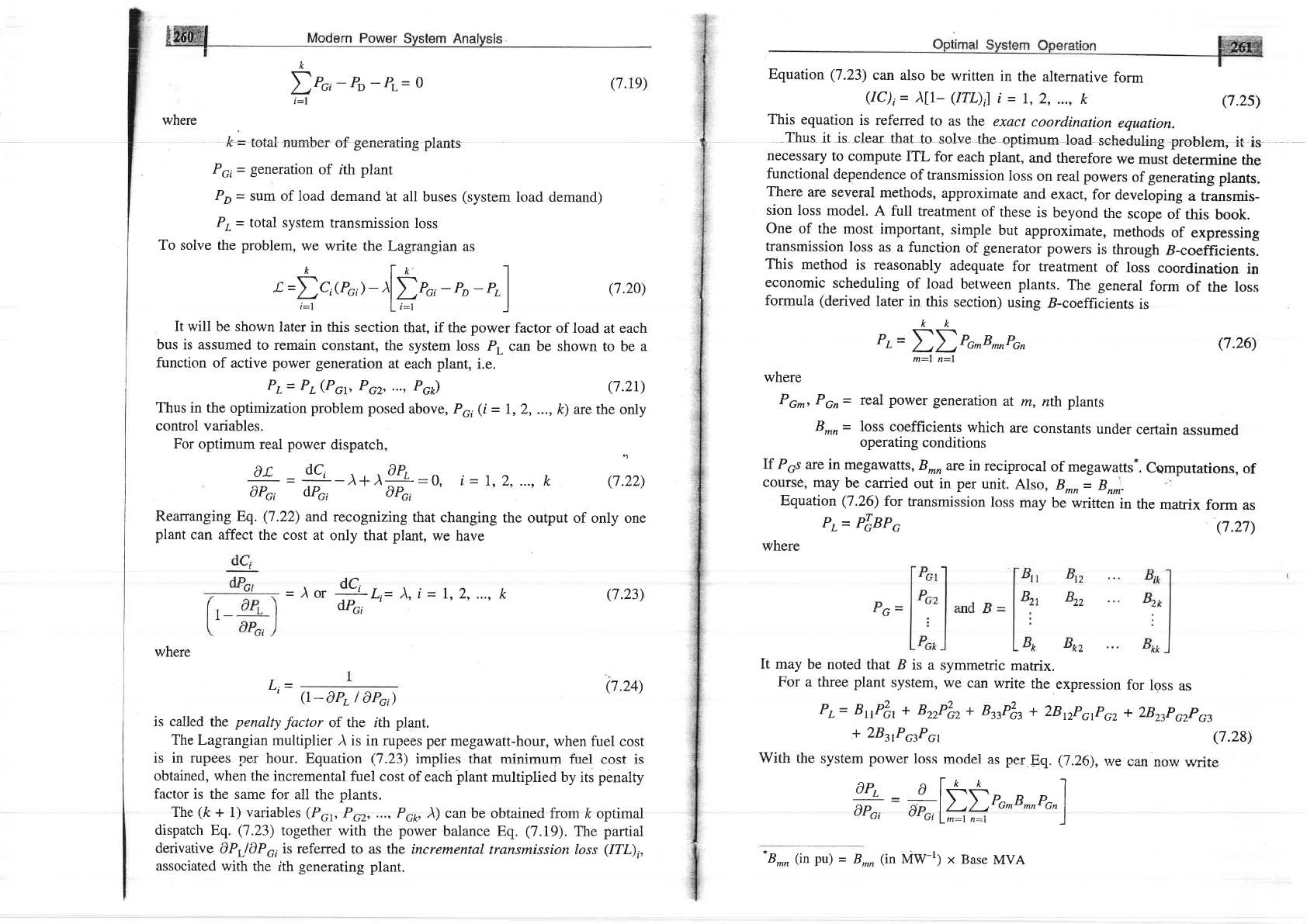
-PI-=
0
where
k
=
tatalr
number
of
generating
plants
Pci=
generation
of lth
plant
Pp
=
sum of load
demand
bt all
buses
(system
load demand)
Pr=
total system
transmission
loss
To solve the problem,
we write
the
Lagrangian
as
k
DP",
-
P,
i:l
(7.re)
(7.23)
(7.20)
It will
be shown
later in
this section
that, if the
power
factor of load
at
each
bus is assumed
to remain constant,
the system
loss P,
can be shown
to be a
function of
active
power
generation
at
each
plant,
i.e.
Pr=
Pt(Pcp
P52, ...,
P51r) (7.2r)
Thus in the
optimization
problem
posed
above, Pci
Q
=
I,2,
..., k) are
the only
control variables.
For
optimum
real
power
dispatch,
')
(7.22)
Rearranging
Eq.
(7
.22) and
recognizing
that
changing
the output
of only one
plant
can affect
the cost at
only that
plant,
we
have
t=tr,(Pc)-^[t""
,
-
Po-".]
i:l
AL
=
dC,
-
\r ,1Pt
-
oPo,
dPGt-
^+ A
#*:O'
i
=
r' 2'
""
k
=
) or
#Li=
), i
=
r,2,
..., k
where
Li=
Q-APL
iAPGi)
(7.24)
is called the
penalty
factor
of the ith
plant.
The Lagrangian
multiplier
)
is
in rupees
per
megawatt-hour,
when
fuel cost
is in rupees
per
hour. Equation
(7.23)
impiies that
minimuqr ftrei
eost is
obtained,
when the
incremental fuel
cost
of each
plant
multiplied by
its
penalty
factor
is the same
for all the
plants.
The
(k
+
1)
variables
(P6r,
P62,...,
Pct,
)) canbe obtained from
k
optimal
dispatch
F,q.
(7.23)
together with
the
power
balance
Eq,.
(1.19).
The
parrial
derivative
)PLIAPGi is referred
to as the
incremental
transmission loss
(ITL),,
associated
with the
lth
generating
plant.
Equation
(7.23)
can
also
be written
in
the
alternative
form
(IC)i-
An-
QTL)if
i
=
1,2,
..., k
(7.2s)
This
equation
is referred
to
as the
exact
coordination
equation.
Thus
it is elear
tha-t
to solve
the
optimum
lead
seheduling
problem;
it
is
necessary
to compute
ITL
for
each plant,
and
therefore
we
must
determine
the
functional
dependence
of transmission
loss
on
real
powers
of
generating
plants.
There
are
several
methods,
approximate
and
exact,
for
developing
a transmis-
sion
loss
model.
A full
treatment
of
these
is
beyond
the
scope
of this
book.
One of
the most
important,
simple
but
approximate,
methods
of expressing
transmission
loss
as
a function
of
generator
powers
is
through
B-coeffrcients.
This
method
is reasonably
adequate
for
treatment
of
loss
coordination
in
economic
scheduling
of load
between
plants.
The general
form
of
the loss
formula
(derived
later
in
this
section)
using
B-coefficients
is
P.
=
II
pG^B*,pGn
m:7
n:I
where
PG^,
PGr=
real
power
generation
at
m,
nth
plants
B^n=
loss coefficients
which
are
constants
under
certain
assumed
operating
conditions
If P6"s
are
in megawatts,
B*n
are in
reciprocal
of
megawatts*.
Cemputations,
of
course,
may
be carried
out in per
unit.
Also,
B*r=
Bn^.
,:
Equation
(7.26)
for transmission
loss
may
be written
in
the
rnatrix
form as
(7.26)
(7.27)
Pr=
PIBPI
Where
It
may
be noted
that B
is
a symmetric
matrix.
For
a three plant
system,
we
can
write
the
expression
for
loss
as
PL=
Bn4,
+ Bzz4,
+ Bzz4,
+
28rrpcrpcz
+ ZBnpGzpG3
+
2BrrPorpo,
e.ZS)
wiih
the
system Dower
ioss
moriei
as
per
Eq.
e.z6),
we c.an
now
write
Ap
^ f
t
o_,
I
*
=
ftl?lPo,"a^^'o')
*B^,
{in
pu)
=
B^n
(in
Mw-t) x
Base
MVA
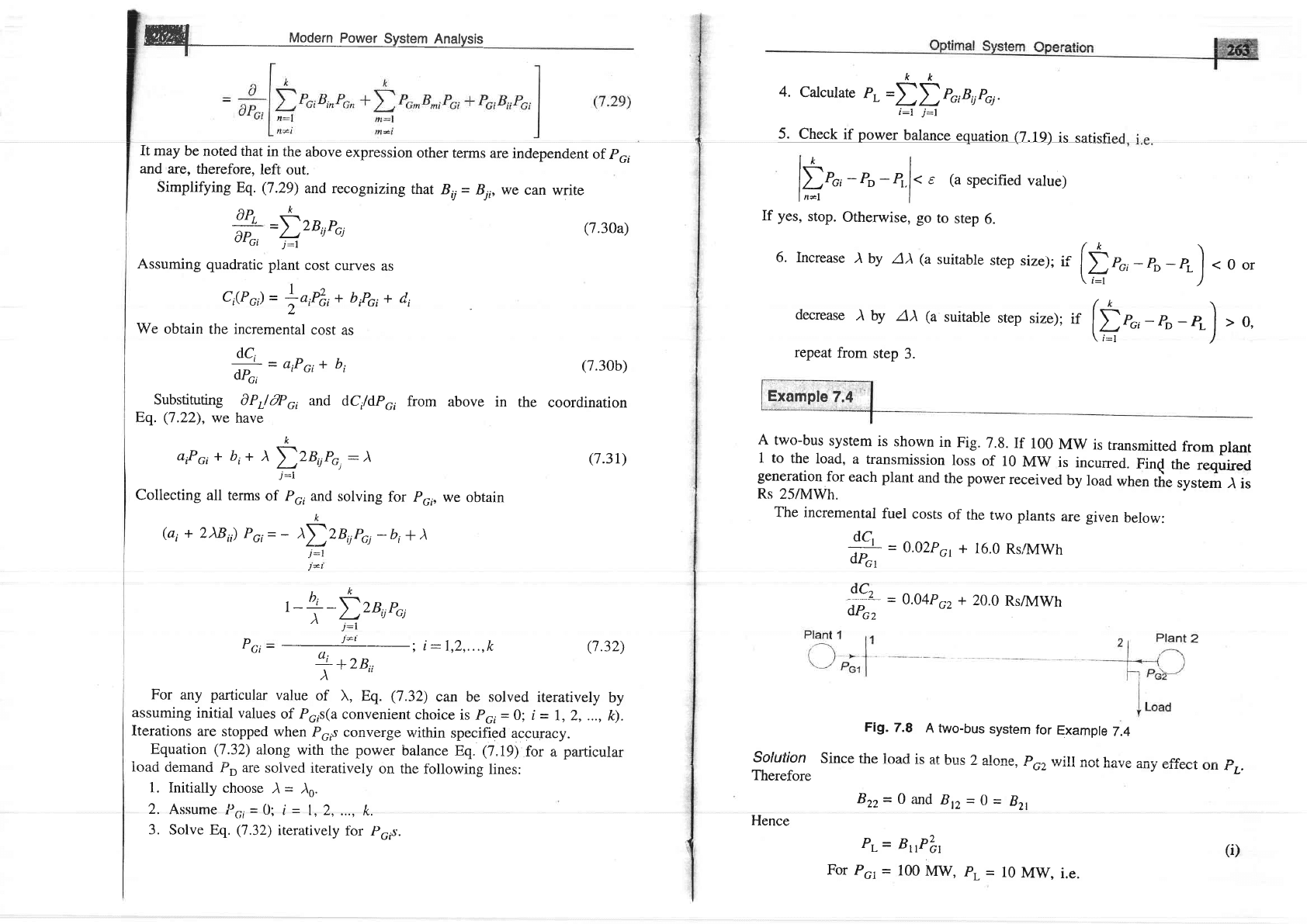
ffif
Modern
Po*er
system
Anatysis
It may
be noted
that
in
the above
expression
other
terms
are independent
of Po,
and are,
therefore,
left
out.
Simplifying
Eq.
(7.29)
and recognizing
that
B,
=
Bir,
we can
write
aPk
-+
=D
zBijpcj
)Fo,
j:l
Assuming
quadratic
plant
cost
curves
as
Ci(Poi)=
*o,4,+
b,p.,+
d,
We
obtain
the incremenlal
cost
as
dc,
dP'
=
atPo'+
b'
Substinrting
APL|&G'
and
dcildPci
from
above in
kk
4.
Calculate
p,
=If
pciBijpcj.
j:l
J=l
5.
Check
if
power
balance
equation
(?. t
o)
is satistied
lsl
lLPot
-
PD
- pr.l'
t
(a
specified
value)
ln*t I
If yes,
stop.
Otherwise,
go
to
step
6.
(7.30a)
(7.30b)
the
coordination
6. Increase
)
by
A)
(a
suitable
decrease
) by
AA
repeat
from
step
3.
step
size)'
tt
[*
pc,
-
^
-
")
step
size);
if
(8",
- po
- p,
<0or
)>0,
Eq.
(7.22),
we
have
k
aiPci+
b,+
Slzn,,ro,:^
(1.3I)
J:l
Collecting
all terrns
of P, and
solving
for Po,
we
obtain
k
(ai
+
2M,,)
Pci=
-
)D
ZBijpGj
-bi
+
^
'-l
J*T
t-
r&
n't-
l-a-
)
'28,,P
^
)
L""ii'Gi
]:I
,,
*rB=;
i-7'2'"''k (7'32)
)
(a
suitable
Example
7,4
'
A
two-bus
system
is
shown
in
Fig.
7.8.
If
100
Mw
is
transmited
from
plant
1 to
the
load,
a transmission
loss
of
10
MW
is
incurred.
Fin(
the
required
generation
for
each plant
and
the power
received
by
load
when
tie
system
,\
is
Rs
25llvlWh.
The
incremental
fuel
costs
of
the
two plants
are
given
below:
dC
A*
-
o'ozPcr
+
16'o
Rs,Mwh
:f:
-
o'o4PG2+
2o.o
Rs/lvIWh
Pc,
For
any
particular
value
of
\,
Eq.
(7.32)
can be solved
iteratively
by
assuming
initial
values
of P6,s(a
convenient
choice
is P",
=
0; i
=
l, 2, ...,
k).
Iterations
are
stopped
when
Po,s converge
within
specified accuracy.
Equation
(7.32)
along with
the
Dower balance F,q,.
(7.19)
for
a
pa-rtieular
ioaci
ciemanci
Po
are soiveci
iteratively
on the
following
lines:
1.
Initially choose
)
=
)0.
2.
Assume
ItGi=
0;
I
=
1,2,
...,
k.
3.
Solve Eq.
(7.32)
iteratively
for Po,s.
6^r- -r:--
outuuon
Therefore
Hence
Fig.
7.8
A two-bus
system
for
Example
7.4
since the
ioad
is
at
bus
z
a\one,
p",
v,.r,!
not
have
any
effect
ort
Fr.
Bzz=
0and
Bn=
0=
Bz,
Pl-=
For
Po,
-
B
nPbr
100
MW,
Pr
=
10
MW,
i.e.
(i)
